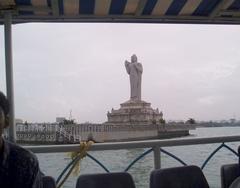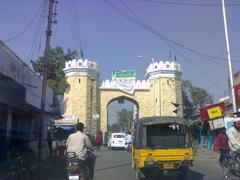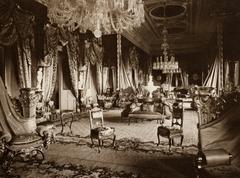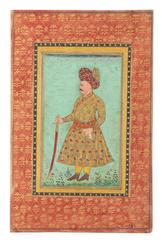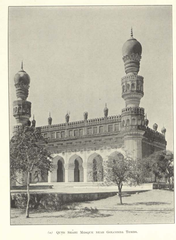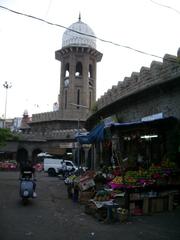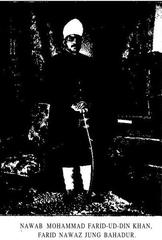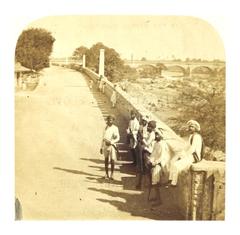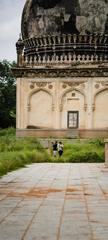
Toli Masjid: Visiting Hours, Tickets, and Historical Significance in Hyderabad
Date: 03/07/2025
Introduction
Toli Masjid, situated in the historic Karwan area of Hyderabad, stands as a splendid example of Qutb Shahi architecture and a living testament to the city’s rich cultural and religious legacy. Built in the late 17th century, this mosque harmoniously blends Persian, Deccani, and indigenous Indian motifs, making it a captivating destination for history lovers, architecture enthusiasts, and spiritual seekers. This detailed guide provides essential information on Toli Masjid visiting hours, ticket requirements, architectural highlights, conservation efforts, and travel tips, ensuring a meaningful and memorable visit.
For further reference, see Wikipedia, Deccan Chronicle, and Hyderabad Tourism.
Table of Contents
- Introduction
- Historical Background and Construction
- The “Damri” Legend
- Architectural Features and Symbolism
- Religious and Community Significance
- Conservation Status and Preservation Efforts
- Visitor Information: Hours, Tickets, and Accessibility
- Travel Tips and Nearby Attractions
- Frequently Asked Questions (FAQ)
- Conclusion and Further Resources
Historical Background and Construction
Toli Masjid, also known as Damri or Damdi Masjid, was constructed in 1671–1672 CE (1082 AH) during the reign of Sultan Abdullah Qutb Shah, the seventh ruler of the Qutb Shahi dynasty (Wikipedia). The mosque’s construction was overseen by Mir Musa Khan Mahaldar, a distinguished noble and architect, who also supervised the building of the grand Mecca Masjid (TravelTriangle). The location—just 2 kilometers from Golconda Fort—situates Toli Masjid along a significant historical route, further enhancing its prominence among Hyderabad historical sites (Holidify).
Originally, the mosque was set within a large garden complex, supported by a waqf (endowment) of 27 acres and five guntas. Over time, urban encroachment reduced these surroundings, but the mosque remains a protected monument, recognized by the Archaeological Survey of India and INTACH (The Islamic Heritage; Deccan Chronicle).
The “Damri” Legend
Toli Masjid’s alternative name, Damri Masjid, is rooted in a unique historical anecdote. While overseeing the Mecca Masjid’s construction, Mir Musa Khan Mahaldar was granted a damri (the smallest copper coin in Mughal currency) for every rupee spent on that project. Accumulating these coins, he funded the construction of Toli Masjid, symbolizing both creativity in patronage and the mosque’s deep roots in local legend (TravelTriangle; Hyderabad Tourism).
Architectural Features and Symbolism
Toli Masjid exemplifies the zenith of Qutb Shahi mosque architecture through its:
- Five-arched façade: Representing the five pillars of Islam, this hallmark of Qutb Shahi design is both structurally and symbolically significant.
- Twin minarets: Approximately 20 meters high, these are adorned with intricate stucco work, floral and geometric motifs, and capped with bulbous domes (Travenix).
- Ornamentation: The mosque features elaborate jaali (lattice) screens, lotus embellishments on arches (symbolizing cultural synthesis), and Persian calligraphy, reflecting the fusion of Islamic and indigenous styles (Triphobo).
- Raised platform: Offers protection from seasonal flooding and provides a vantage point over the Karwan suburb.
- Interior details: The main prayer hall contains Persian inscriptions, floral arabesques, and relief stucco work demonstrating the exceptional craftsmanship of Qutb Shahi artisans.
The combination of these features highlights Hyderabad’s cosmopolitan ethos during the Qutb Shahi era and the mosque’s ongoing spiritual and architectural relevance (Travenix).
Religious and Community Significance
Since its inception, Toli Masjid has been a vital center for the local Muslim community, hosting daily prayers, Friday congregations, and major Islamic festivals such as Eid al-Fitr and Eid al-Adha (OMAstrology). The mosque also serves as a venue for community events, educational sessions, charitable activities, and life-cycle rituals. Its enduring function as an active place of worship underscores its living heritage.
Notably, the mosque’s communal origins—funded through the damri concession—reflect the collective faith and effort that continues to characterize its role in contemporary Hyderabad.
Conservation Status and Preservation Efforts
Structural Condition
Despite its resilience, Toli Masjid faces several conservation challenges:
- Structural deterioration: Cracks, water seepage, and the loss of original stucco details threaten the mosque’s integrity (The Hindu).
- Urban encroachment: Encroaching developments have reduced the original garden and waqf land, impacting the mosque’s setting.
- Pollution and neglect: Weathering and insufficient maintenance contribute to gradual decay (Siasat).
Recent Initiatives
In December 2021, Telangana’s Department of Heritage allocated ₹2 crore towards Toli Masjid’s restoration, including structural reinforcements and traditional-material repairs. However, bureaucratic delays and fund release issues have postponed full-scale conservation work (The Hindu; New Indian Express). Heritage experts and organizations like INTACH recommend using original materials and techniques to maintain the mosque’s authenticity and minimize disturbance (INTACH).
Community Engagement
Public awareness, heritage walks, and educational programs are increasingly emphasized as vital strategies for safeguarding the mosque’s future (New Indian Express).
Visitor Information: Hours, Tickets, and Accessibility
Location and Access
- Address: KPHS Colony, Karwan, Hyderabad, Telangana
- Proximity: Approx. 2 km from Golconda Fort; accessible by auto-rickshaw, taxi, or city bus (GoDigit)
Visiting Hours
- General Hours: Open daily from 8:00 AM to 6:00 PM; some sources indicate 6:00 AM – 8:00 PM or 9:00 AM – 5:00 PM. For the most accurate hours, confirm locally before visiting.
- Best Time to Visit: Early morning or late afternoon for optimal lighting and relaxed exploration. Avoid Fridays and festival periods if you prefer fewer crowds (MakeMyTrip).
Ticket Information
- Entry Fee: Free for all visitors.
Dress Code & Etiquette
- Modest attire required (arms and legs covered; headscarf recommended for women).
- Footwear must be removed before entry.
- Maintain silence and respect worshippers; avoid flash photography inside the prayer hall.
Accessibility
- Wheelchair access is limited due to historic steps; assistance may be needed.
- Restrooms are not available inside; limited public facilities nearby.
- Street parking is available but can be crowded during prayer times.
Guided Tours
- Not routinely available on-site; heritage walks featuring Toli Masjid are occasionally organized by groups like INTACH (New Indian Express).
Travel Tips and Nearby Attractions
- Combine Visits: Plan a heritage trail including Golconda Fort and Qutb Shahi Tombs.
- Photography: Exterior and courtyard photography is encouraged; seek permission before photographing interiors or worshippers.
- Safety: The area is generally safe, but usual urban precautions are advised. Crowds peak during major religious events.
- Conservation Support: Join heritage walks or support authorized restoration efforts.
Nearby Attractions
- Golconda Fort (Wikipedia)
- Qutb Shahi Tombs
- Charminar
- Mecca Masjid
Each can be included in a full-day tour of Hyderabad’s historic core.
Frequently Asked Questions (FAQ)
Q1: What are the visiting hours of Toli Masjid?
A1: Generally, 8:00 AM to 6:00 PM daily; confirm locally for any seasonal changes.
Q2: Is there an entry fee or ticket required?
A2: No, entry is free for all visitors.
Q3: Are guided tours available?
A3: Occasionally, through heritage groups like INTACH or local tourism operators.
Q4: Is the mosque wheelchair accessible?
A4: Accessibility is limited due to steps and elevated platforms.
Q5: Can I take photographs inside the mosque?
A5: Photography is permitted in exterior and courtyard areas; ask for permission before photographing interiors or worshippers.
Q6: What is the best time to visit Toli Masjid?
A6: October to March, during Hyderabad’s cooler months.
Conclusion
Toli Masjid is an architectural gem that embodies Hyderabad’s rich Islamic heritage and the artistic achievements of the Qutb Shahi dynasty. Despite modern challenges, the mosque’s enduring beauty and community significance make it a rewarding destination for all who seek to engage with the city’s layered history. Respectful tourism and active participation in heritage initiatives are essential for preserving this monument for future generations.
Call to Action
Enhance your Hyderabad journey by including Toli Masjid in your itinerary. For up-to-date information on visiting hours, guided tours, and conservation news, download the Audiala app and explore our related articles. Stay engaged with the heritage community by participating in heritage walks, supporting local conservation, and sharing your experiences on social media.
Further Resources and References
- Toli Masjid – Wikipedia
- Deccan Chronicle – Toli Masjid
- Travenix – Best Mosques in Hyderabad
- The Hindu – Conservation Work
- GoDigit – Mosques in Hyderabad
- Hyderabad Tourism – Historical Places
- India Tourism – Hyderabad Attractions
- INTACH
- Archaeological Survey of India
- Siasat – Endangered Heritage Sites
- New Indian Express – Preserving Heritage
- MakeMyTrip – Places to Visit in Hyderabad
- Wanderlog – Toli Masjid
- OMAstrology – Toli Masjid
- The Islamic Heritage – Toli Masjid
- Triphobo – Toli Masjid
- redBus Blog – Pilgrimage Destinations



